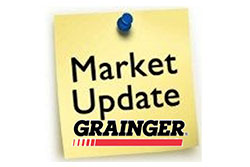16 Distribution Industry Trends for 2016
 Over the past month, Allen and I have discussed our observations regarding the industry and shared trends we see that we think will impact business for distributors and manufacturers in 2016. We’ve agreed upon 16 sales, marketing, profitability and operations opportunities that we’d like to share.
Over the past month, Allen and I have discussed our observations regarding the industry and shared trends we see that we think will impact business for distributors and manufacturers in 2016. We’ve agreed upon 16 sales, marketing, profitability and operations opportunities that we’d like to share.
While the economy is undergoing gyrations given the world economy, global politics and the petro-chem markets, we decided not to focus on these issues (since they are beyond the electrical industry’s control) and focus on what distributors and manufacturers can, and in some cases will, do to differentiate themselves, take market share to outperform on the top line and, perhaps most importantly, ensure a healthy bottom line.
This version has been shortened to hit the highlights. If you’d like a copy of the complete version, with expanded thoughts / rationale, give us a call or email us (Allen, David)
Here’s two people’s thoughts for 2016. Let us know yours.
- Much has been spent by some on eCommerce and more will be spent in 2016 with system costs declining and industry focused resources gaining increased visibility. The distributors who, once launched, invest in the resources / strategies to gain customer adoption will attain customer preference.
- eBusiness, defined as beyond your e-store, will take on greater prominence, require more investment and generate new management challenges for manufacturers and distributors. Issues such as CRM, content marketing, content syndication and more will require focused personnel with an unclear ROI.
- Connected systems, be they lighting, building automation, home networks, IIoT and more become new customer expectations. Distributors can sell the equipment, maybe the software / service, perhaps participate in subscription fees, be engaged in data monitoring / management / reporting and offer analytic services. But will manufacturers and lighting reps let distributors participate?
- Do more with less. More will, and has been, requested of distributors but with material pricing (due to commodities, competition, lack of inflation, etc) keeping material costs down, and operating costs continue to rise, distributors need to continue to drive down operational costs.
- Distributor information collection will & needs to improve. Distributors need to know more about their customers, their customers’ customers and more. Data matters … and it’s not just sales data or product data. Information enables gap analysis selling and marketing, segmentation marketing and niche marketing. Growth comes from combining data and strategy.
- Voice of XXX as a stakeholder is important. If you are a manufacturer, this means your reps / sales organization, distributors, et al…. For distributors, it’s your salespeople, your reps, your customers and others. All impact profitability and the key to success is capturing their share of mind.
- Live your brand. To customers, distributors can sound like a commodity. Everyone has good service. Everyone has good people. Everyone sells quality products. Everyone says they carry inventory. Everyone says they can deliver. Everyone says …. So what’s the difference?
- Want improvement? Invest in a metric management culture. Reviewing data and crafting metrics provides insights to drive direction and engender accountability.
- Acquisitions will continue but the “core” has been taken out of the middle.
- As uncertainty in the marketplace increases, decision making slows as many managers and owners/CEO’s have aged (some say “lost interest”) in the business or are comfortable where they are. Inertia is a powerful competitor.
- Rebirth of private labeling. (click here for the first article or email us for the complete report) The use of un-labeled and private labeled products from contract manufacturers grows.
- Distributors use their own number schema to open their purchasing up to broader horizons…essentially most items are generics. Additionally, some distributors use “scrambled” SKUs online to inhibit product price comparisons.
- Synchronized data enables faster SPA claim backs. There are now distributors that file claims within 7 days of a sale and are credited back the morning of the 7th day. Just like distributors want to reduce their DSOs, so too do they want to reduce outstanding SPAs.
- Moneyball results for Distributors: Product data synchronization, combined with predictive analytics can grow top line revenue and bottom line results. While there are tools for medium to large distributors, companies like Insight Analytics are targeting the <$30 million distributor with a SaaS / outsource model. Larger companies are using Sales Management Plus, Tour de Force, Tableau, Phocas and other tools.
- Lighting opportunities accelerate for those who invest. Investment in specialists is critical, unless you want to be an order-taker. The traditional Big 3 lamp lines are no more and the fixture line-up is changing.
- The electrical patchwork economy continues. Some areas soft, others not. Those who take share will be ones that can execute … out-sell, out-service, out-think … while optimizing processes and managing costs.
Succeeding in 2016 will take determination and commitment. The “devil is in the details”. Ask us (Allen, David) for the expanded version and how to capitalize on these 16 Distribution Trends for Success in 2016.
Your thoughts? What trends do you see as keys to success in 2016?






















